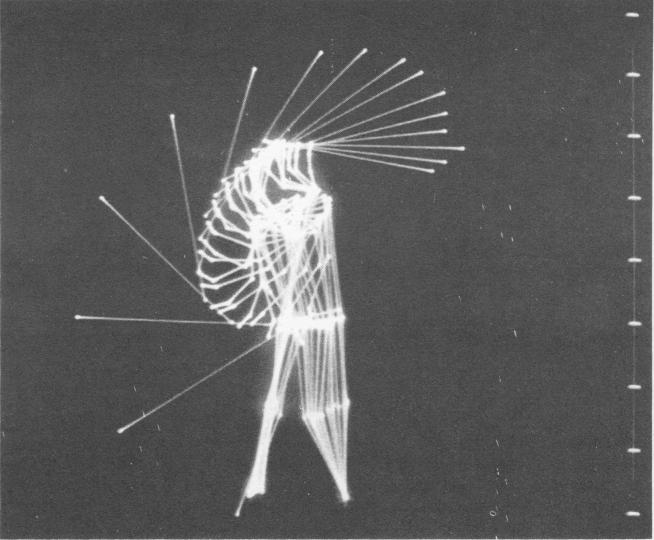| Previous | Index | Next |
![]()
r,We can surpass all physical
limits. Computer
training enables us to see movement
beyond human perception. 4)
swimmers on a computer system at Teachers College, Columbia University. "With the computer we can evaluate each of a swimmer's movements and eliminate all the tiny flaws that the swimmer doesn't notice and the coach can't see. Even Olympic-caliber swimmers can improve their times significantly through our computer training techniques."
Schleihauf uses a
computer system devised by Dr. Gideon Ariel, the former Israeli discus hurler, who is now director of computer sciences and mechanics for the U.S Olympic Committee "The human eye cannot quantify human movement," he says "The important
things in performance-the timing, the relative speeds of dozens of limb and body segments, the changes in center of gravity-all must be measured, weighed, and compared scientifically to be of any use "
The future of sport, says Dr Irv Dardik, of the Council on Sports Medicine, rests in the hands of science Coaches will become scientists. Computers, behaviorism, biomechanics, and genetics will help create perfectly tuned athletes New tools will usher in an age in which human perceptions are too limited to train human bodies
"How can the human eye tell whether an athlete has turned his shoulder a degree too far to the left or stopped a centimeter short when releasing the ball'?" Ariel asks "In fact, it can't But the computer can evaluate many elements at once
Ariel's better-than-human eye begins with a camera that shoots an athlete's motion at up to 10,000 frames a second These high-speed images are protected onto a screen over an array of 20,000 extremely sensitive microphones A special sonic pen is used to trace the athlete's position in each photo frame Microphones pick up the signals and relay them to a computer that animates a stick figure on a video
Golf swings and other movements can reach per tecbon with computer techniques (above) but meat and desire as shown by boxer Chuck Wep ner (left). are essential for athletic excellence
screen The stick figure simulates a full sequence of athletic movements, which can be frozen at any point for observation.
Ariel uses this setup to determine an athlete's center of gravity, velocity, acceleration, direction, angle of attack, and force. It gives him a fixed image of the relationship of every part of an athlete's body to every other part at all stages of movement, allowing the tiniest flaws in technique to be studied and corrected without guesswork
"When a swimmer is working out," he says, "the coach can't tell whether his hand motion produces the most thrust, whether his starting dive is as effective as possible, whether the angle of his arm entry generates the least resistance We study the athlete in the gym We test him in flumes with stress pulleys attached so that we can gauge the force generated by many different movements We create a pattern through the computer of the best possible series of motions This we compare with the swimmer's performance in the pool Only then can the coach know exactly where the swimmer is working to best advantage and where he isn't Before the advent of computers, coaches were merely guessing '
The emerging science of sport will work with athletes minds as well as with their bodies It encompasses programs from broad social schemes to minute manipulations of behavior It is "a holistic approach. utilizing psychology as well as physiology.
sociology, and medicine," according to Dr. Marvin Clein, of the Human Performance Laboratory, in Denver.
"Already," declares Dr. Jakow Bielski, a psychologist at City University of New York, "it is common today among athletes, regardless of class, to assume that performance is about twenty percent physical and eighty percent mental. This understanding alone typifies a new kind of emerging athlete, one who stands much removed from the inherently physical athlete of time not so far past."
Dr. Bielski points to the mental edge that lifted the American hockey team over the physically superior team sent by
the USSR in last winter's Olympic Games as an example of the power of behaviorism in athletics. "However, the real impact of this shift to a more mental, systematic approach to sports," Bielski says, "is yet to be seen. The future athlete will implement behavior-control advancements so that even spontaneity will be controlled."
Right now scientists are looking for ways to assist athletes in eliminating mental blocks and integrating the workings of their minds and muscles Dr Richard O'Brien, of Hofstra University, in New York, is using hypnosis and relaxation techniques to help athletes conquer suppressed fears Dr. O'Brien worked with boxer Duane Bobick, who had the disastrous habit of "freezing up in the first round." O'Brien, employing hypnosis, discovered a seething caldron of fears and insecurities that paralyzed the fighter in the ring He took Bobick through a treatment of 20-minute tension-relaxation sessions. First, he'd tell the fighter to tense his muscles. then to relax them Next he'd go on to internalized routines, with Bobick relaxing himself by concentrating on soothing thoughts Finally, Bobick grew so adept at willing himself to relax that he overcame his first-round handicap completely
Dr Clein is working on systems to improve athletes' "muscle memory" He believes the athlete rises or falls on a kind of intelligence that Clein calls fluid O'Brien, a zealous supporter of Clein's ideas, says,
OMNI July 1980

![]()
| Previous | Index | Next |